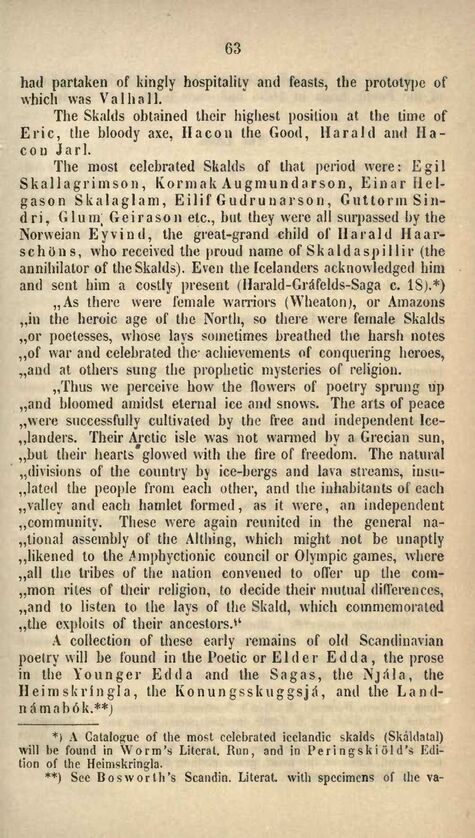
Full resolution (JPEG) - On this page / på denna sida - The Old Norsk Poetry and the Sagas

<< prev. page << föreg. sida << >> nästa sida >> next page >>
Below is the raw OCR text
from the above scanned image.
Do you see an error? Proofread the page now!
Här nedan syns maskintolkade texten från faksimilbilden ovan.
Ser du något fel? Korrekturläs sidan nu!
This page has been proofread at least once.
(diff)
(history)
Denna sida har korrekturlästs minst en gång.
(skillnad)
(historik)
had partaken of kingly hospitality and feasts, the prototype of
which was Valhall.
The Skalds obtained their highest position at the time of
Eric, the bloody axe, Hacon the Good, Harald and
Hacon Jarl.
The most celebrated Skalds of that period were: Egil
Skallagrimson, Kormak Augmundarson, Einar
Helgason Skalaglam, Eilif Gudrunarson, Guttorm
Sindri, Glum Geirason etc., but they were all surpassed by the
Norweian Eyvind, the great-grand child of Harald
Haarschöns, who received the proud name of Skaldaspillir (the
annihilator of the Skalds). Even the Icelanders acknowledged him
and sent him a costly present (Harald-Gráfelds-Saga c. 18).[1]
„As there were female warriors (Wheaton), or Amazons
in the heroic age of the North, so there were female Skalds
or poetesses, whose lays sometimes breathed the harsh notes
of war and celebrated the achievements of conquering heroes,
and at others sung the prophetic mysteries of religion.
Thus we perceive how the flowers of poetry sprung up
and bloomed amidst eternal ice and snows. The arts of peace
were successfully cultivated by the free and independent
Icelanders. Their Arctic isle was not warmed by a Grecian sun,
but their hearts glowed with the fire of freedom. The natural
divisions of the country by ice-bergs and lava streams,
insulated the people from each other, and the inhabitants of each
valley and each hamlet formed, as it were, an independent
community. These were again reunited in the general
national assembly of the Althing, which might not be unaptly
likened to the Amphyctionic council or Olympic games, where
all the tribes of the nation convened to offer up the
common rites of their religion, to decide their mutual differences,
and to listen to the lays of the Skald, which commemorated
the exploits of their ancestors.“
A collection of these early remains of old Scandinavian
poetry will be found in the Poetic or Elder Edda, the prose
in the Younger Edda and the Sagas, the Njála, the
Heimskríngla, the Konungsskuggsjá, and the
Landnámabók.[2]
<< prev. page << föreg. sida << >> nästa sida >> next page >>